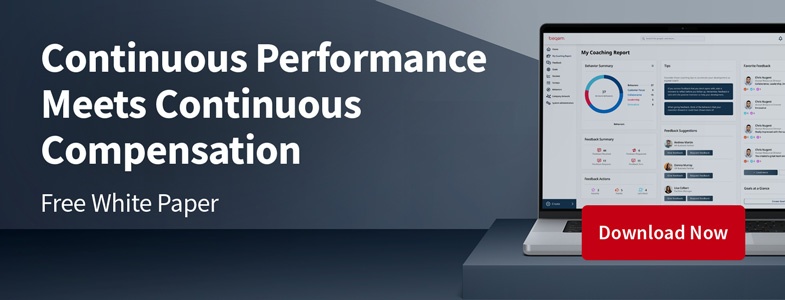The End of the Road for Calibration?

Learn more about the following beqom products
Calibration, the process of trying to standardize employee performance ratings across a company, has sometimes been defined as the most reviled practice in HR.
The process happens behind closed doors so not everyone even knows it exists. The intent is good: “let’s align on what great performance looks like, let’s ensure consistency and fairness in the evaluation and compensation of our people.”
However, the reality often plays out very differently. Is there a better way?
The problem of subjectivity in ratings and comparison
Calibration finds itself in a pool of subjectivity. As Harvard Business Review points out, most performance evaluations are biased. Leaders often take defensive positions in backing their own people, to secure those top boxes of the rating curve, at the sacrifice of another department’s people. It also rarely involves real data or objective evidence that validates a point of view. As such, it often ends up in a subjective view of opinions, where the loudest voice is most often heard. It also has the disadvantage that the comparisons can be unfair and unhelpful.
Now consider the fact that this process may happen more than once in an organization. Some may have three different calibration cycles:
- Calibration for performance ratings. Where you get all the ratings and try to make sure they are consistent, i.e., if everyone is “exceptional” then the ratings are not differentiating.
- Calibration for compensation. After increases are applied based on the performance ratings, you may find you can’t afford them and have to go through another process to fairly allocate the merit increase budget.
- Calibration for talent. Another evaluation is done to assess who are the best performers for promotion to be future leaders.
How do you compare one individual’s performance to another, particularly when specialist roles or unique responsibilities are a factor? Indeed, is it even right to compare people at all? Inevitably, it ends up being an uncomfortable or even hostile experience for many. This has led to many challenges and ultimately unfairness, the very thing it aimed to avoid. In many respects, calibration in its purest form rarely lives up to the promise.
“Leveling” and grounding the performance rating curve
As many companies exited calibration in favor of more progressive forms of performance management, others remained with different versions of the practice. So where do we find ourselves now?
Is it time to end calibration? Or do we have an alternative to deliver on the original intent?
The aim of calibration still feels relevant: aligning on what great performance looks like in an effort to improve the fairness and the accuracy of performance reviews and related compensation. After all, if you work for a manager who has a highly optimistic view of his own team and will tend to over inflate ratings, it’s pretty unfair if you find yourself with the opposite type of leader, who will be more prone to harsh ratings and a pessimistic view of your team’s performance. These alignment sessions can be and sometimes were helpful in assisting managers to work through a ‘leveling’ and a grounding on the performance rating curve.
Well, there are new answers to calibration that do live up to its original intent. Arguably, the label and much of the practice are reducing and reshaping themselves as many walk away from the practice. Fortunately, new practices are emerging with a much more inspiring intent. There’s a new kid in town and thankfully it’s a far more inspiring practice than its predecessor.
Aligning on “great performance”
So called “Talent Days” or “People Days” have arrived and are giving managers the opportunity to align on great performance and compensation allocation. They are also aligning on sharing their thoughts and evaluating what “great” looks like, but with the purest of intent. Many of these days are oriented around “how do we help this individual grow and accelerate their potential.”
The practice is simplicity itself and with wholly good intent that takes an individual’s current capability, performance, and skillset, and defines how to take those to the next level. Managers share thoughts and ideas with other managers and even find cross-functional opportunities that may benefit the individual.
The “People Days” practice can also lead to very tangible actions such as identifying appropriate mentors. These tangible actions also include defining clear career path opportunities and unifying around what exceptional performance looks like. While they are veering more toward the talent management category of talent reviews, we see a merging of the two practices. It opens the conversation on what great performance looks like. And, when we see great performance, how do we accelerate the potential of that individual?
With performance management tied to compensation management, during “People Days” you can do all the calibration at one time. You now have all the employee information needed to make all these decisions: Did they achieve goals? Are they living the values? What is their compensation history? What is their peer feedback? What is their development plan? and so on. By having all the data available you improve the process in two ways:
- It’s more efficient because you do calibration only one time.
- It’s more effective and fair because you are introducing objectivity and removing bias.
The new practices of performance management
As ratings and matrices take a back seat to the new practices of performance management, the good news is they are being replaced by great conversations that fulfill the original purest intent of performance management. This intent is to let people know where they stand and hold them to account for their performance. It is achieved by aligning on what that great performance looks like, recognizing great performance and managing underperformance.
It’s difficult to know how widespread these practices are. We have certainly seen a lot of variations of this at our client sites. Yet little has been written about the new practices that are emerging. One thing is for sure, the new practices are inspiring and wholeheartedly good. We see these highly welcomed by managers, who still bear the scars of the former calibration era. We say “bravo” to those companies embracing the new paradigm.
beqom Continuous Performance Management (CPM) can help drive meaningful conversations in your organization through our use of check-ins and other features. beqom Total Compensation Management (TCM) can provide the platform you need to make informed and fair compensation decisions. To discover more about how beqom’s performance and compensation solutions can help you build a continuous feedback culture, and replace old calibration processes with efficient and effective performance and compensation cycles, contact one of our friendly specialists.








